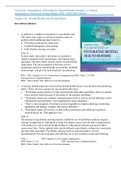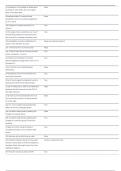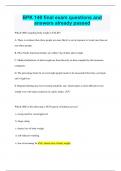Varcarolis’ Foundations of Psychiatric Mental Health Nursing: A Clinical
Approach, by Margaret Jordan Halter, PhD, APRN 8th Edition
Chapter 01: Mental Health and Mental Illness
MULTIPLE CHOICE
1. A staff nurse completes orientation to a psychiatric unit.
This nurse may expect an advanced practice nurse to
perform which additional intervention? a. Conduct mental health assessments.
b. Prescribe psychotropic medication.
c. Establish therapeutic relationships.
d. Individualize nursing care plans.
ANS: B
In most states, prescriptive privileges are granted to
master’s-prepared nurse practitioners and clinical nurse
specialists who have taken special courses on prescribing
medication. The nurse prepared at the basic level is
permitted to perform mental health assessments, establish
relationships, and provide individualized care planning.
PTS: 1 DIF: Cognitive Level: Understand (Comprehension) REF: Page 1-23 TOP:
Nursing Process: Implementation
MSC: Client Needs: Safe, Effective Care Environment
2. A nursing student expresses concerns that mental health nurses “lose all their clinical nursing
skills.” Select the best response by the mental health nurse.
a. “Psychiatric nurses practice in safer environments than other specialties. Nurse-to-patient
ratios must be better because of the nature of the patients’ problems.”
b. “Psychiatric nurses use complex communication skills as well as critical thinking to solve
multidimensional problems. I am challenged by those situations.”
c. “That’s a misconception. Psychiatric nurses frequently use high technology monitoring
equipment and manage complex intravenous therapies.”
d. “Psychiatric nurses do not have to deal with as much pain and suffering as medical–
surgical nurses do. That appeals to me.”
ANS: B
The practice of psychiatric nursing requires a different set of skills than medical–surgical
nursing, though there is substantial overlap. Psychiatric nurses must be able to help patients
with medical as well as mental health problems, reflecting the holistic perspective these
nurses must have. Nurse–patient ratios and workloads in psychiatric settings have increased,
just like other specialties. Psychiatric nursing involves clinical practice, not just
documentation. Psychosocial pain and suffering are as real as physical pain and suffering.
PTS: 1 DIF: Cognitive Level: Apply (Application)
REF: Pages 1-2, 21 TOP: Nursing Process: Implementation
MSC: Client Needs: Safe, Effective Care Environment
1
, 3. When a new bill introduced in Congress reduces funding for care of persons diagnosed with
mental illness, a group of nurses write letters to their elected representatives in opposition to
the legislation. Which role have the nurses fulfilled?
a. Recovery
b. Attending
c. Advocacy
d. Evidence-based practice
ANS: C
An advocate defends or asserts another’s cause, particularly when the other person lacks the
ability to do that for self. Examples of individual advocacy include helping patients
understand their rights or make decisions. On a community scale, advocacy includes political
activity, public speaking, and publication in the interest of improving the human condition.
Since funding is necessary to deliver quality programming for persons with mental illness, the
letter-writing campaign advocates for that cause on behalf of patients who are unable to
articulate their own needs.
PTS: 1 DIF: Cognitive Level: Understand (Comprehension) REF: Page 1-26 TOP:
Nursing Process: Evaluation
MSC: Client Needs: Safe, Effective Care Environment
4. A family has a long history of conflicted relationships among the members. Which family
member’s comment best reflects a mentally healthy perspective?
a. “I’ve made mistakes but everyone else in this family has also.”
b. “I remember joy and mutual respect from our early years together.”
c. “I will make some changes in my behavior for the good of the family.”
d. “It’s best for me to move away from my family. Things will never change.”
ANS: C
The correct response demonstrates the best evidence of a healthy recognition of the
importance of relationships. Mental health includes rational thinking, communication skills,
learning, emotional growth, resilience, and self-esteem. Recalling joy from earlier in life may
be healthy, but the correct response shows a higher level of mental health. The other incorrect
responses show blaming and avoidance.
PTS: 1 DIF: Cognitive Level: Analyze (Analysis)
REF: Pages 1-2, 3, 32 (Figure 1-1) TOP: Nursing Process: Assessment MSC:
Client Needs: Psychosocial Integrity
5. Which assessment finding most clearly indicates that a patient may be experiencing a mental
illness? The patient
a. reports occasional sleeplessness and anxiety.
b. reports a consistently sad, discouraged, and hopeless mood.
c. is able to describe the difference between “as if” and “for real.”
d. perceives difficulty making a decision about whether to change jobs.
2
, ANS: B
The correct response describes a mood alteration, which reflects mental illness. The
distracters describe behaviors that are mentally healthy or within the usual scope of human
experience.
PTS: 1 DIF: Cognitive Level: Apply (Application)
REF: Pages 1-2 to 4 TOP: Nursing Process: Assessment
MSC: Client Needs: Psychosocial Integrity
6. Which finding best indicates that the goal “Demonstrate mentally healthy behavior” was
achieved for an adult patient? The patient
a. sees self as capable of achieving ideals and meeting demands.
b. behaves without considering the consequences of personal actions.
c. aggressively meets own needs without considering the rights of others.
d. seeks help from others when assuming responsibility for major areas of own life.
ANS: A
The correct response describes an adaptive, healthy behavior. The distracters describe
maladaptive behaviors.
PTS: 1 DIF: Cognitive Level: Apply (Application)
REF: Pages 1-2 to 4 TOP: Nursing Process: Evaluation
MSC: Client Needs: Psychosocial Integrity
7. A nurse encounters an unfamiliar psychiatric disorder on a new patient’s admission form.
Which resource should the nurse consult to determine criteria used to establish this diagnosis? a.
International Statistical Classification of Diseases and Related Health Problems
(ICD-10)
b. The ANA’s Psychiatric-Mental Health Nursing Scope and Standards of Practice
c. Diagnostic and Statistical Manual of Mental Disorders (DSM-V)
d. A behavioral health reference manual
ANS: C
The DSM-V gives the criteria used to diagnose each mental disorder. It is the official guideline
for diagnosing psychiatric disorders. The distracters may not contain diagnostic criteria for a
psychiatric illness.
PTS: 1 DIF: Cognitive Level: Apply (Application)
REF: Pages 1-18, 19 TOP: Nursing Process: Assessment
MSC: Client Needs: Safe, Effective Care Environment
8. A nurse wants to find a description of diagnostic criteria for anxiety disorders. Which resource
would have the most complete information?
a. Nursing Outcomes Classification (NOC)
b. DSM-V
c. The ANA’s Psychiatric-Mental Health Nursing Scope and Standards of Practice d. ICD-10
3
, ANS: B
The DSM-V details the diagnostic criteria for psychiatric clinical conditions. It is the official
guideline for diagnosing psychiatric disorders. The other references are good resources but do
not define the diagnostic criteria.
PTS: 1 DIF: Cognitive Level: Understand (Comprehension)
REF: Pages 1-18, 19 TOP: Nursing Process: Implementation
MSC: Client Needs: Safe, Effective Care Environment
9. Which individual is demonstrating the highest level of resilience? One who
a. is able to repress stressors.
b. becomes depressed after the death of a spouse.
c. lives in a shelter for 2 years after the home is destroyed by fire.
d. takes a temporary job to maintain financial stability after loss of a permanent job.
ANS: D
Resilience is closely associated with the process of adapting and helps people facing
tragedies, loss, trauma, and severe stress. It is the ability and capacity for people to secure the
resources they need to support their well-being. Repression and depression are unhealthy.
Living in a shelter for 2 years shows a failure to move forward after a tragedy. See related
audience response question.
PTS: 1 DIF: Cognitive Level: Apply (Application) REF: Pages 1-5, 6
TOP: Nursing Process: Assessment
MSC: Client Needs: Psychosocial Integrity
10. Complete this analogy. NANDA: clinical judgment: NIC: a. patient
outcomes.
b. nursing actions.
c. diagnosis.
d. symptoms.
ANS: B
Analogies show parallel relationships. NANDA, the North American Nursing Diagnosis
Association, identifies diagnostic statements regarding human responses to actual or potential
health problems. These statements represent clinical judgments. NIC (Nursing Interventions
Classification) identifies actions provided by nurses that enhance patient outcomes. Nursing
care activities may be direct or indirect.
PTS: 1 DIF: Cognitive Level: Analyze (Analysis)
REF: Pages 1-21, 22 TOP: Nursing Process: Evaluation
MSC: Client Needs: Safe, Effective Care Environment
11. An adult says, “Most of the time I’m happy and feel good about myself. I have learned that
what I get out of something is proportional to the effort I put into it.” Which number on this
mental health continuum should the nurse select?
4






